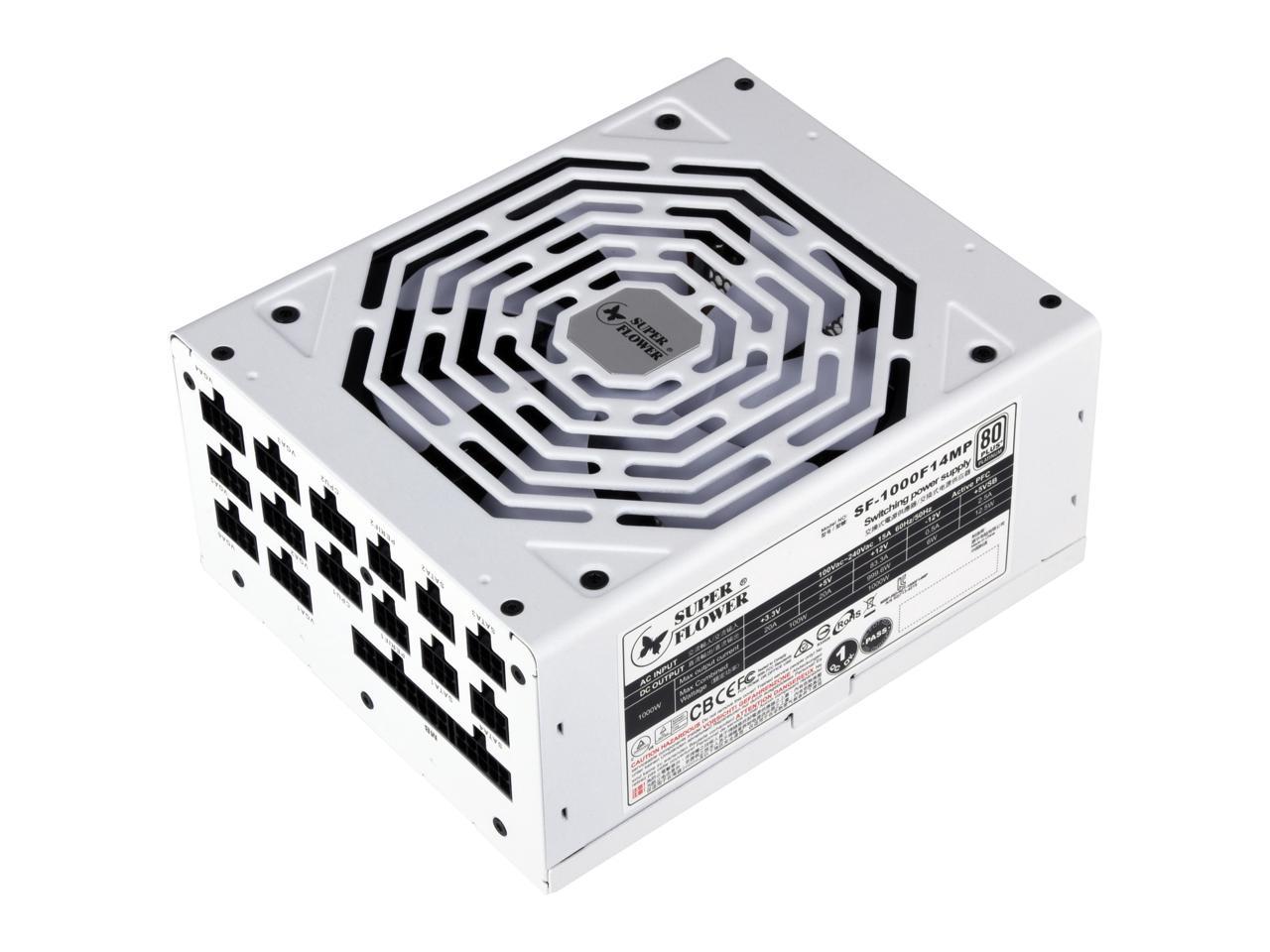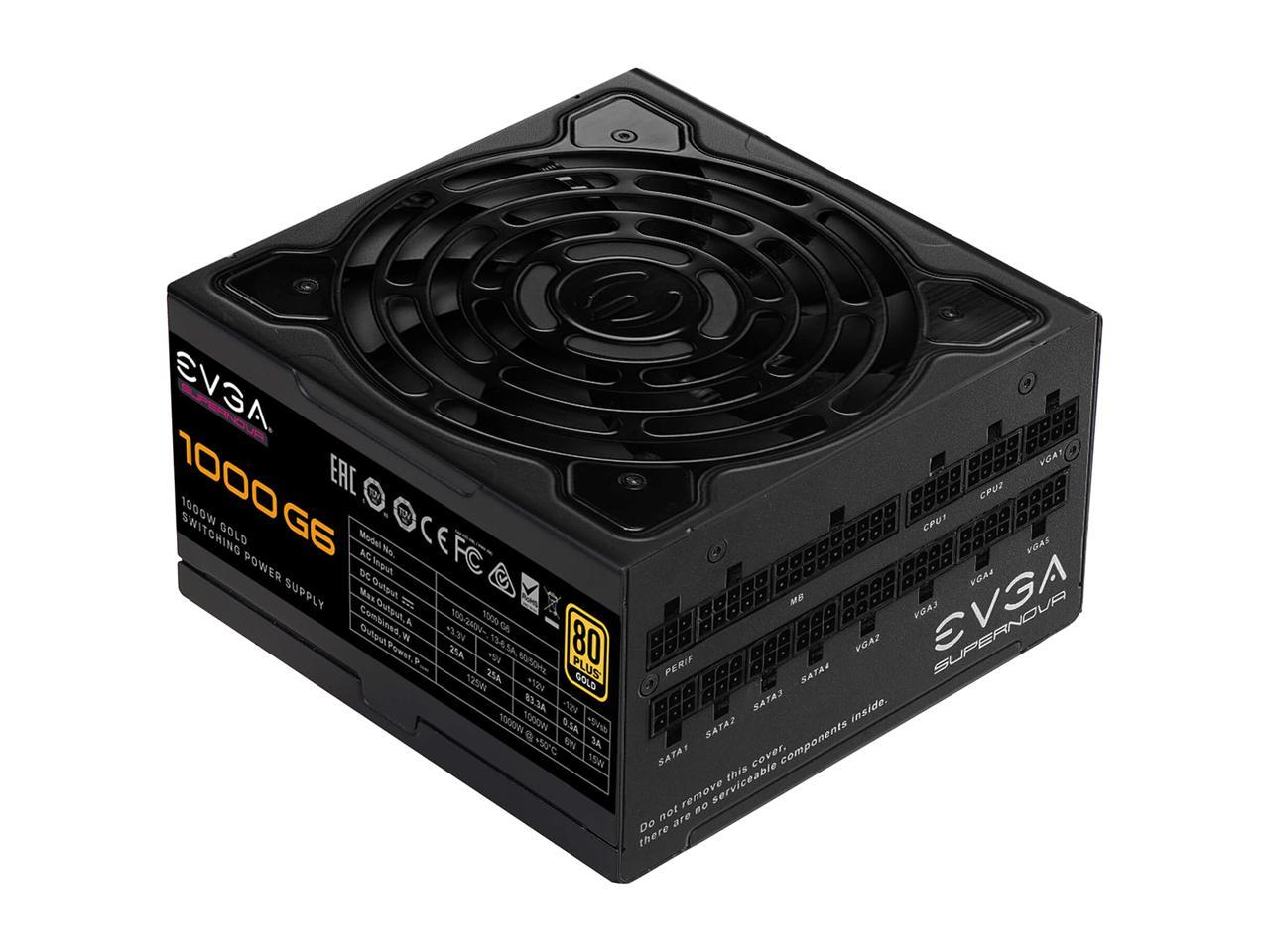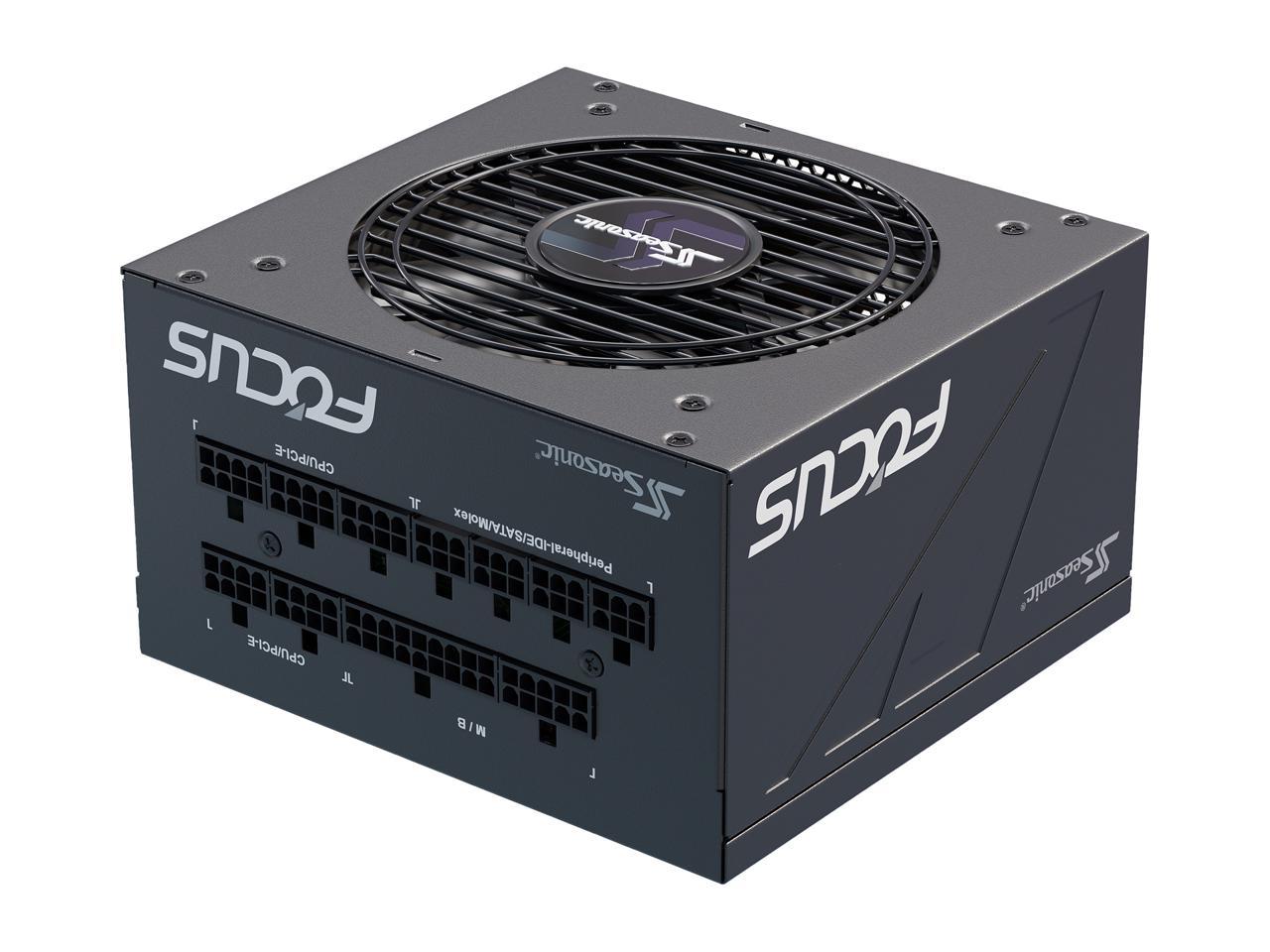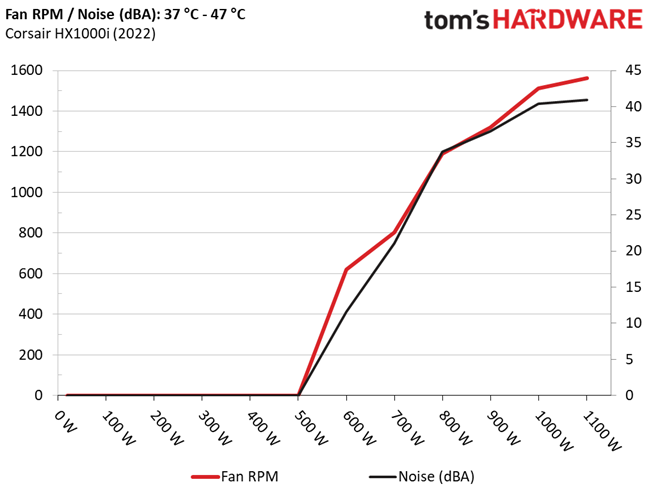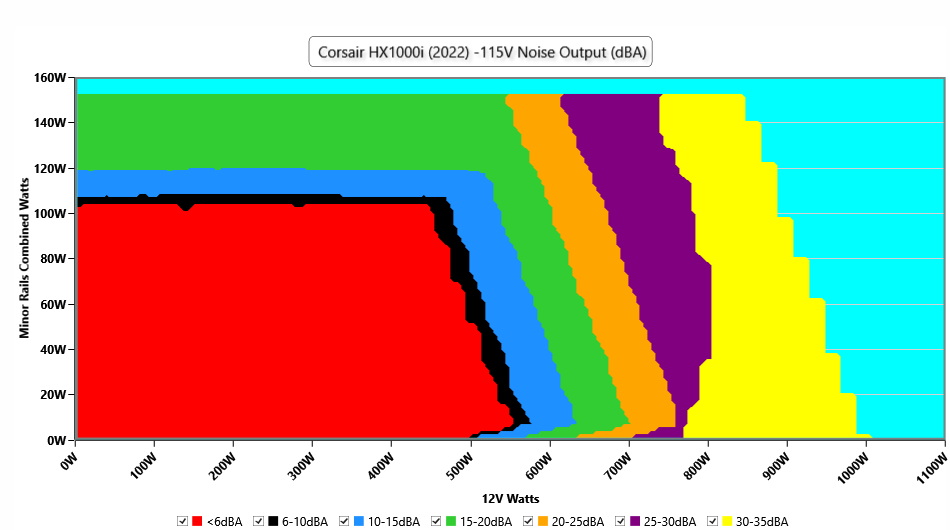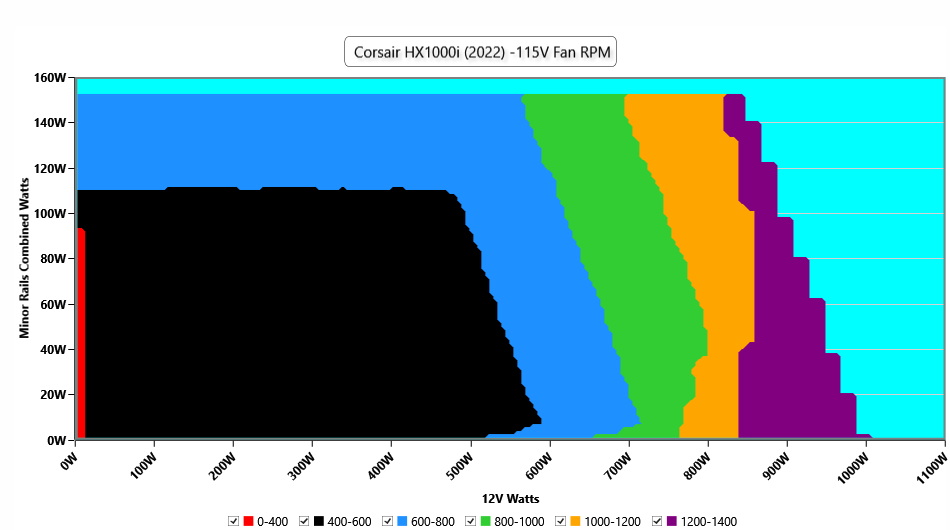Why you can trust Tom's Hardware
To learn more about our PSU tests and methodology, please check out How We Test Power Supply Units.
Primary Rails And 5VSB Load Regulation
The following charts show the main rails' voltage values recorded between a range of 40W up to the PSU's maximum specified load, along with the deviation (in percent). Tight regulation is an important consideration every time we review a power supply because it facilitates constant voltage levels despite varying loads. Tight load regulation also, among other factors, improves the system’s stability, especially under overclocked conditions and, at the same time, it applies less stress to the DC-DC converters that many system components utilize.
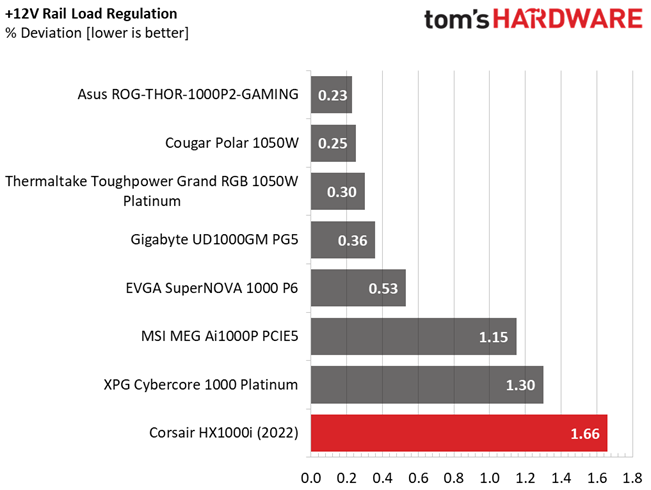
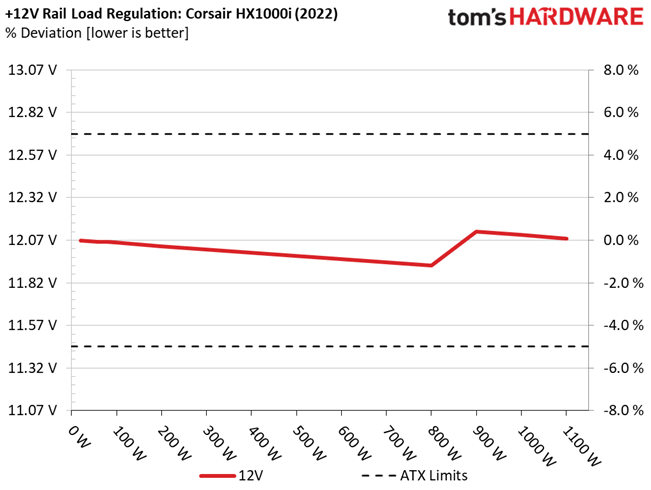
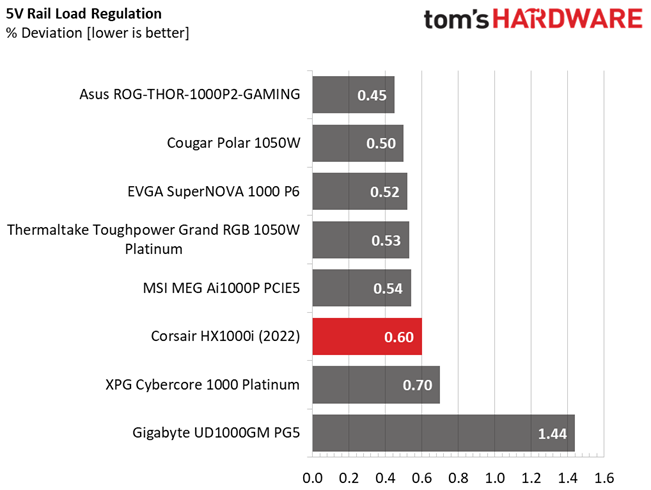
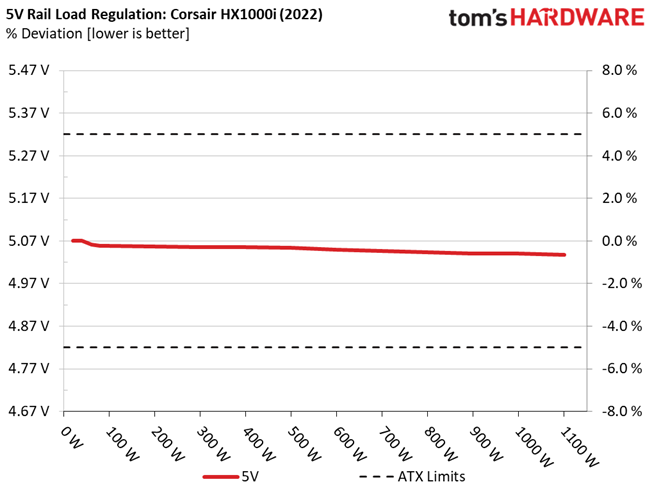

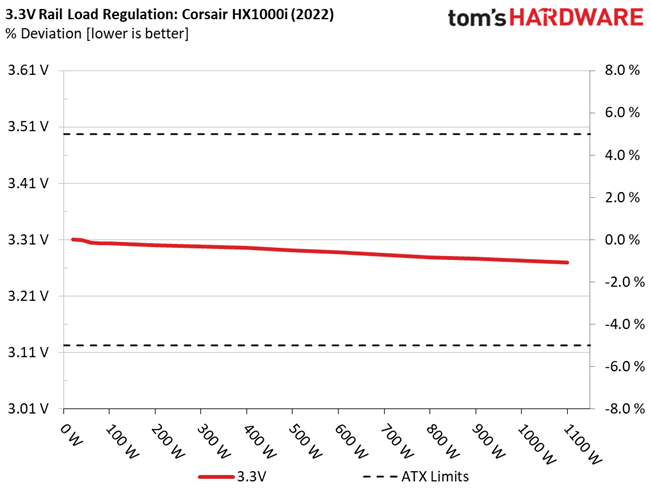
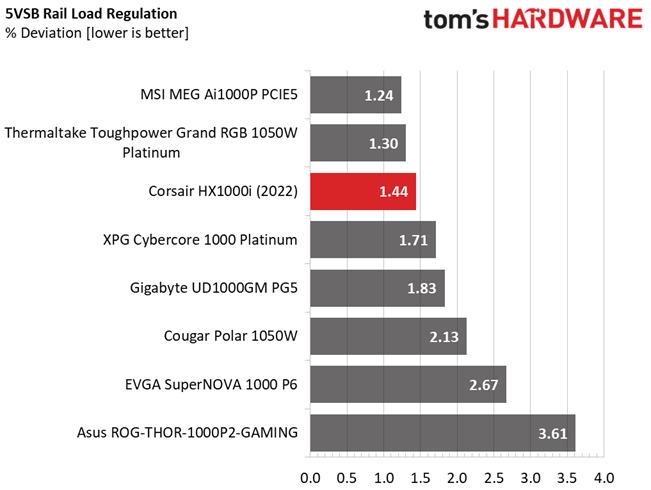
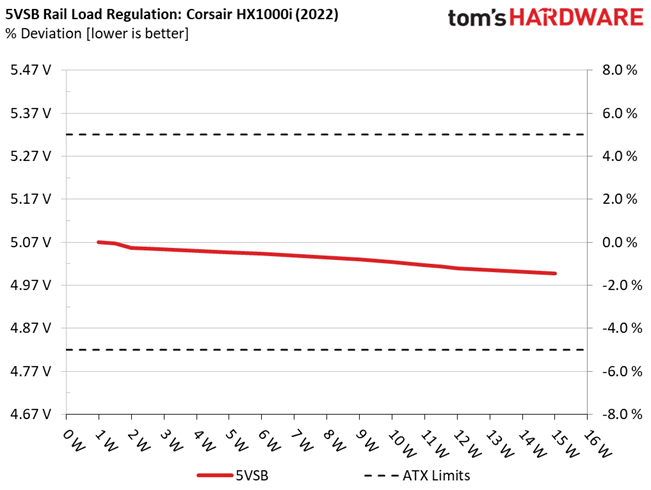
Because of a notable change at 12V in the 800-900W range, load regulation takes a hit. Load regulation should be within 1% at 3.3V, too.
Hold-Up Time
Put simply; hold-up time is the amount of time that the system can continue to run without shutting down or rebooting during a power interruption.
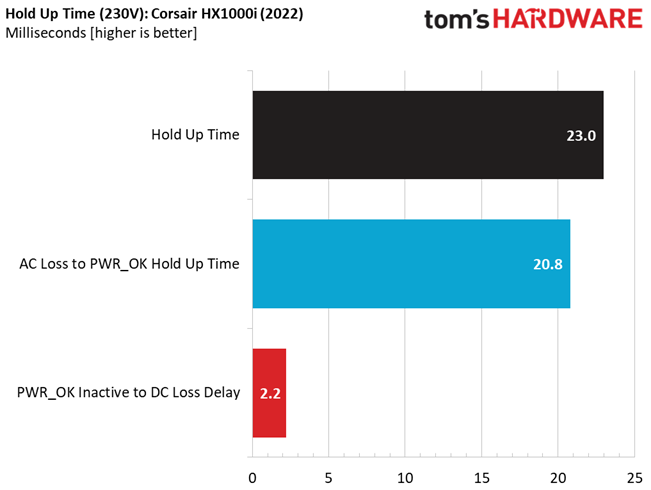
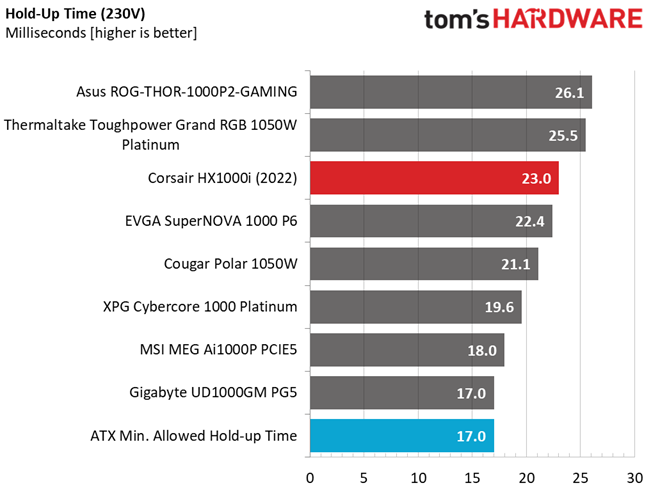
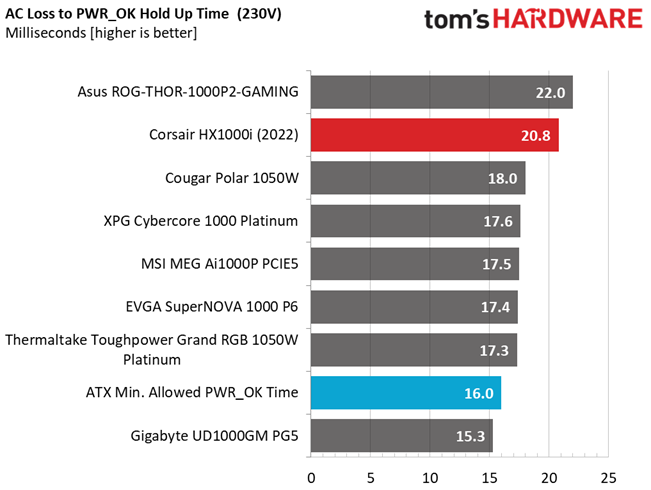
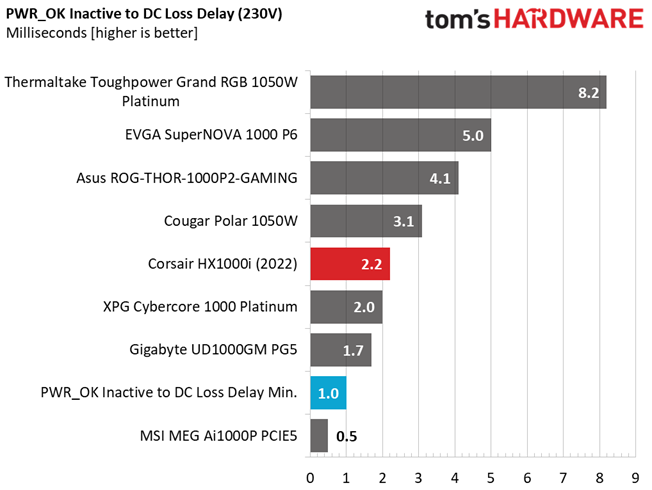
The hold-up time is long and the power ok signal is accurate.
Inrush Current
Inrush current, or switch-on surge, refers to the maximum, instantaneous input current drawn by an electrical device when it is first turned on. A large enough inrush current can cause circuit breakers and fuses to trip. It can also damage switches, relays, and bridge rectifiers. As a result, the lower the inrush current of a PSU right as it is turned on, the better.


The inrush current is low with 115V, but pretty high with 230V.
Get Tom's Hardware's best news and in-depth reviews, straight to your inbox.
Leakage Current
In layman's terms, leakage current is the unwanted transfer of energy from one circuit to another. In power supplies, it is the current flowing from the primary side to the ground or the chassis, which in the majority of cases is connected to the ground. For measuring leakage current, we use a GW Instek GPT-9904 electrical safety tester instrument.
The leakage current test is conducted at 110% of the DUT's rated voltage input (so for a 230-240V device, we should conduct the test with 253-264V input). The maximum acceptable limit of a leakage current is 3.5 mA and it is defined by the IEC-60950-1 regulation, ensuring that the current is low and will not harm any person coming in contact with the power supply's chassis.
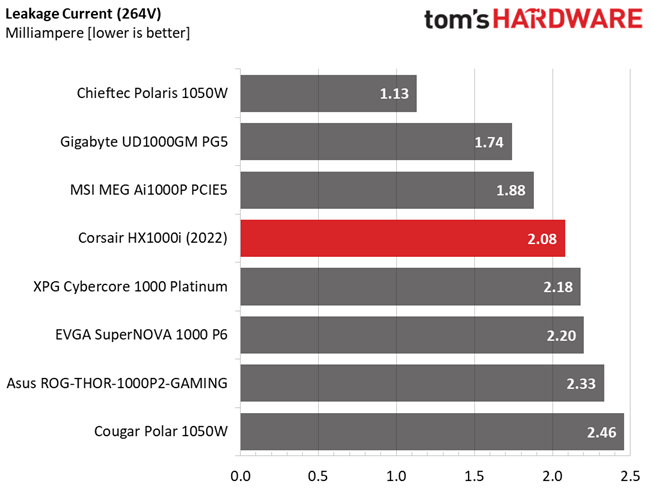
Leakage current is low.
10-110% Load Tests
These tests reveal the PSU's load regulation and efficiency levels under high ambient temperatures. They also show how the fan speed profile behaves under increased operating temperatures.
| Test | 12V | 5V | 3.3V | 5VSB | DC/AC (Watts) | Efficiency | Fan Speed (RPM) | PSU Noise (dB[A]) | Temps (In/Out) | PF/AC Volts |
| 10% | 6.505A | 1.978A | 1.999A | 0.992A | 100.046 | 89.194% | 0 | <6.0 | 44.37°C | 0.968 |
| Row 2 - Cell 0 | 12.059V | 5.056V | 3.302V | 5.042V | 112.168 | Row 2 - Cell 6 | Row 2 - Cell 7 | Row 2 - Cell 8 | 40.02°C | 114.91V |
| 20% | 14.047A | 2.968A | 3.001A | 1.191A | 200.02 | 91.882% | 0 | <6.0 | 45.6°C | 0.99 |
| Row 4 - Cell 0 | 12.039V | 5.055V | 3.299V | 5.039V | 217.762 | Row 4 - Cell 6 | Row 4 - Cell 7 | Row 4 - Cell 8 | 40.75°C | 114.89V |
| 30% | 21.966A | 3.463A | 3.504A | 1.391A | 300.1 | 92.558% | 0 | <6.0 | 46.56°C | 0.996 |
| Row 6 - Cell 0 | 12.020V | 5.054V | 3.297V | 5.034V | 324.298 | Row 6 - Cell 6 | Row 6 - Cell 7 | Row 6 - Cell 8 | 41.38°C | 114.87V |
| 40% | 29.891A | 3.959A | 4.009A | 1.591A | 399.928 | 92.621% | 0 | <6.0 | 47.29°C | 0.996 |
| Row 8 - Cell 0 | 12.000V | 5.053V | 3.294V | 5.03V | 431.686 | Row 8 - Cell 6 | Row 8 - Cell 7 | Row 8 - Cell 8 | 41.6°C | 114.84V |
| 50% | 37.486A | 4.95A | 5.016A | 1.791A | 499.639 | 92.235% | 0 | <6.0 | 48.18°C | 0.996 |
| Row 10 - Cell 0 | 11.981V | 5.052V | 3.29V | 5.025V | 541.709 | Row 10 - Cell 6 | Row 10 - Cell 7 | Row 10 - Cell 8 | 42.07°C | 114.81V |
| 60% | 45.171A | 5.945A | 6.027A | 1.993A | 600.176 | 91.485% | 619 | 11.6 | 42.23°C | 0.997 |
| Row 12 - Cell 0 | 11.963V | 5.048V | 3.286V | 5.019V | 656.013 | Row 12 - Cell 6 | Row 12 - Cell 7 | Row 12 - Cell 8 | 48.89°C | 114.79V |
| 70% | 52.815A | 6.942A | 7.041A | 2.196A | 699.912 | 90.601% | 801 | 21.1 | 43.2°C | 0.998 |
| Row 14 - Cell 0 | 11.943V | 5.044V | 3.282V | 5.012V | 772.614 | Row 14 - Cell 6 | Row 14 - Cell 7 | Row 14 - Cell 8 | 50.21°C | 114.76V |
| 80% | 60.545A | 7.938A | 8.055A | 2.297A | 799.924 | 89.825% | 1190 | 33.7 | 43.53°C | 0.998 |
| Row 16 - Cell 0 | 11.925V | 5.041V | 3.278V | 5.009V | 890.584 | Row 16 - Cell 6 | Row 16 - Cell 7 | Row 16 - Cell 8 | 51.61°C | 114.73V |
| 90% | 67.411A | 8.438A | 8.55A | 2.399A | 899.705 | 88.972% | 1318 | 36.6 | 44.47°C | 0.998 |
| Row 18 - Cell 0 | 12.123V | 5.039V | 3.275V | 5.005V | 1011.181 | Row 18 - Cell 6 | Row 18 - Cell 7 | Row 18 - Cell 8 | 53.67°C | 114.7V |
| 100% | 75.186A | 8.937A | 9.078A | 3.005A | 999.735 | 88.241% | 1513 | 40.4 | 45.86°C | 0.998 |
| Row 20 - Cell 0 | 12.104V | 5.038V | 3.272V | 4.993V | 1133.056 | Row 20 - Cell 6 | Row 20 - Cell 7 | Row 20 - Cell 8 | 56.01°C | 114.67V |
| 110% | 82.914A | 9.934A | 10.189A | 3.006A | 1100.352 | 87.093% | 1561 | 40.9 | 47.34°C | 0.998 |
| Row 22 - Cell 0 | 12.085V | 5.036V | 3.268V | 4.991V | 1263.625 | Row 22 - Cell 6 | Row 22 - Cell 7 | Row 22 - Cell 8 | 58.27°C | 114.65V |
| CL1 | 0.117A | 17.923A | 18.1A | 0A | 151.349 | 83.929% | 692 | 17.2 | 42.17°C | 0.986 |
| Row 24 - Cell 0 | 12.054V | 5.04V | 3.293V | 5.081V | 180.36 | Row 24 - Cell 6 | Row 24 - Cell 7 | Row 24 - Cell 8 | 48.64°C | 114.88V |
| CL2 | 0.116A | 24.786A | 0A | 0A | 126.455 | 82.12% | 708 | 17.9 | 43.41°C | 0.982 |
| Row 26 - Cell 0 | 12.063V | 5.045V | 3.304V | 5.109V | 154.035 | Row 26 - Cell 6 | Row 26 - Cell 7 | Row 26 - Cell 8 | 50.85°C | 114.89V |
| CL3 | 0.116A | 0A | 25.08A | 0A | 83.896 | 75.728% | 1043 | 29.8 | 44.36°C | 0.933 |
| Row 28 - Cell 0 | 12.060V | 5.054V | 3.289V | 5.046V | 110.757 | Row 28 - Cell 6 | Row 28 - Cell 7 | Row 28 - Cell 8 | 52.61°C | 114.9V |
| CL4 | 82.652A | 0A | 0A | 0A | 1000.229 | 88.808% | 1355 | 37.3 | 45.91°C | 0.998 |
| Row 30 - Cell 0 | 12.101V | 5.052V | 3.28V | 5.036V | 1126.268 | Row 30 - Cell 6 | Row 30 - Cell 7 | Row 30 - Cell 8 | 55.87°C | 114.67V |
The PSU can handle heat, even when loaded beyond its official rating, but you should not overdo it, if you want to keep it healthy.
20-80W Load Tests
In the following tests, we measure the PSU's efficiency at loads significantly lower than 10% of its maximum capacity (the lowest load the 80 PLUS standard measures). This is important for representing when a PC is idle with power-saving features turned on.
| Test | 12V | 5V | 3.3V | 5VSB | DC/AC (Watts) | Efficiency | Fan Speed (RPM) | PSU Noise (dB[A]) | Temps (In/Out) | PF/AC Volts |
| 20W | 1.232A | 0.493A | 0.499A | 0.197A | 20.017 | 74.208% | 0 | <6.0 | 40.22°C | 0.676 |
| Row 2 - Cell 0 | 12.073V | 5.068V | 3.309V | 5.065V | 26.999 | Row 2 - Cell 6 | Row 2 - Cell 7 | Row 2 - Cell 8 | 37.12°C | 114.93V |
| 40W | 2.710A | 0.691A | 0.698A | 0.296A | 40.017 | 80.983% | 0 | <6.0 | 41.53°C | 0.736 |
| Row 4 - Cell 0 | 12.069V | 5.068V | 3.308V | 5.063V | 49.477 | Row 4 - Cell 6 | Row 4 - Cell 7 | Row 4 - Cell 8 | 38.22°C | 114.92V |
| 60W | 4.190A | 0.89A | 0.899A | 0.396A | 60.018 | 83.408% | 0 | <6.0 | 42.59°C | 0.756 |
| Row 6 - Cell 0 | 12.066V | 5.059V | 3.304V | 5.052V | 71.944 | Row 6 - Cell 6 | Row 6 - Cell 7 | Row 6 - Cell 8 | 38.81°C | 114.93V |
| 80W | 5.667A | 1.088A | 1.099A | 0.495A | 79.993 | 87.255% | 0 | <6.0 | 43.14°C | 0.923 |
| Row 8 - Cell 0 | 12.062V | 5.057V | 3.303V | 5.05V | 91.718 | Row 8 - Cell 6 | Row 8 - Cell 7 | Row 8 - Cell 8 | 39.2°C | 114.93V |
There is no need for the fan to spin at loads below 100W, even at high temperatures.
2% or 10W Load Test
From July 2020, the ATX spec requires 70% and higher efficiency with 115V input. The applied load is only 10W for PSUs with 500W and lower capacities, while for stronger units, we dial 2% of their max-rated capacity.
| 12V | 5V | 3.3V | 5VSB | DC/AC (Watts) | Efficiency | Fan Speed (RPM) | PSU Noise (dB[A]) | Temps (In/Out) | PF/AC Volts |
| 1.432A | 0.31A | 0.31A | 0.052A | 20.159 | 73.983% | 0 | <6.0 | 27.8°C | 0.681 |
| Row 2 - Cell 0 | 12.075V | 5.06V | 3.304V | 5.059V | 27.255 | Row 2 - Cell 6 | Row 2 - Cell 7 | 27.44°C | 114.94V |
The recommended 70% efficiency mark is easily passed, with a two percent load.
Efficiency & Power Factor
Next, we plotted a chart showing the PSU's efficiency at low loads and loads from 10 to 110% of its maximum rated capacity. The higher a PSU’s efficiency, the less energy goes wasted, leading to a reduced carbon footprint and lower electricity bills. The same goes for Power Factor.
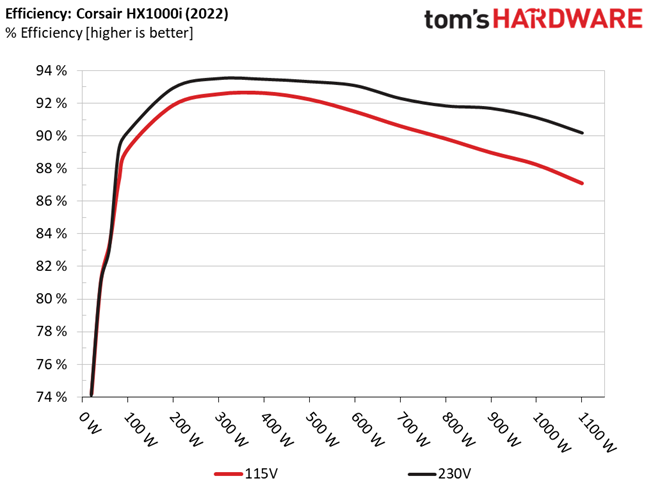

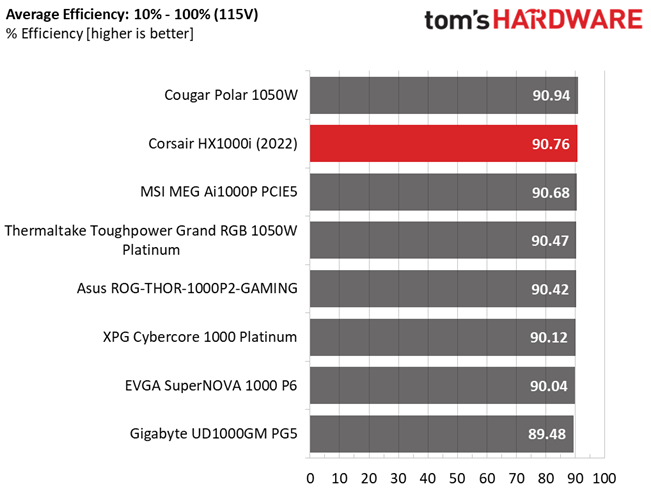
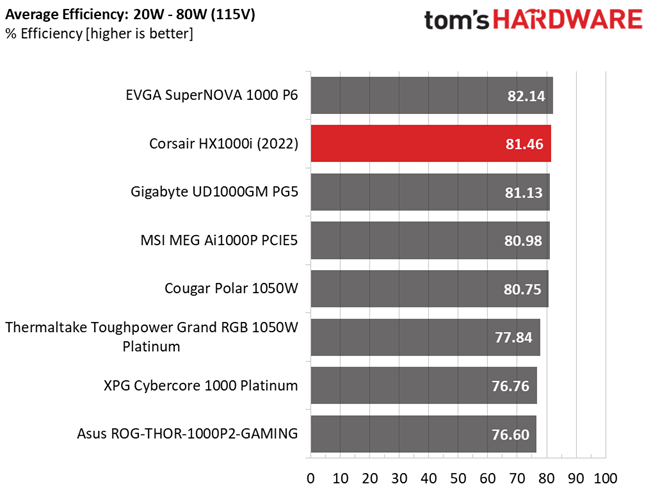


Efficiency is high on all load regions.
5VSB Efficiency
| Test # | 5VSB | DC/AC (Watts) | Efficiency | PF/AC Volts |
| 1 | 0.1A | 0.498W | 74.831% | 0.052 |
| Row 2 - Cell 0 | 4.98V | 0.666W | Row 2 - Cell 3 | 114.93V |
| 2 | 0.25A | 1.245W | 78.254% | 0.121 |
| Row 4 - Cell 0 | 4.975V | 1.591W | Row 4 - Cell 3 | 114.93V |
| 3 | 0.55A | 2.731W | 79.269% | 0.238 |
| Row 6 - Cell 0 | 4.965V | 3.445W | Row 6 - Cell 3 | 114.92V |
| 4 | 1A | 4.95W | 78.682% | 0.359 |
| Row 8 - Cell 0 | 4.949V | 6.291W | Row 8 - Cell 3 | 114.93V |
| 5 | 1.5A | 7.398W | 78.508% | 0.438 |
| Row 10 - Cell 0 | 4.931V | 9.424W | Row 10 - Cell 3 | 114.92V |
| 6 | 3.001A | 14.64W | 77.091% | 0.53 |
| Row 12 - Cell 0 | 4.879V | 18.991W | Row 12 - Cell 3 | 114.92V |
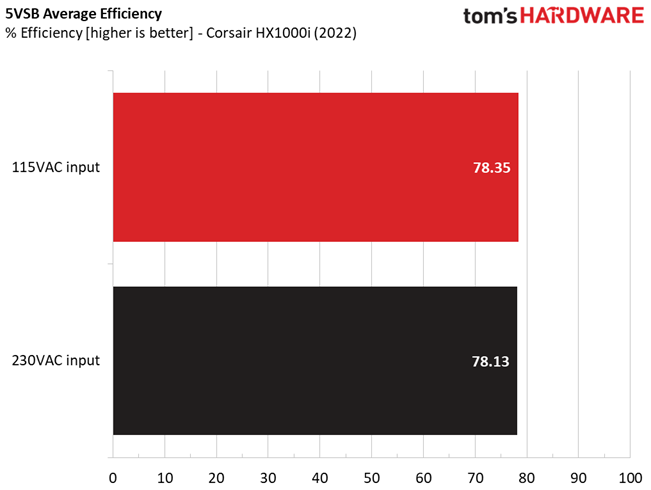
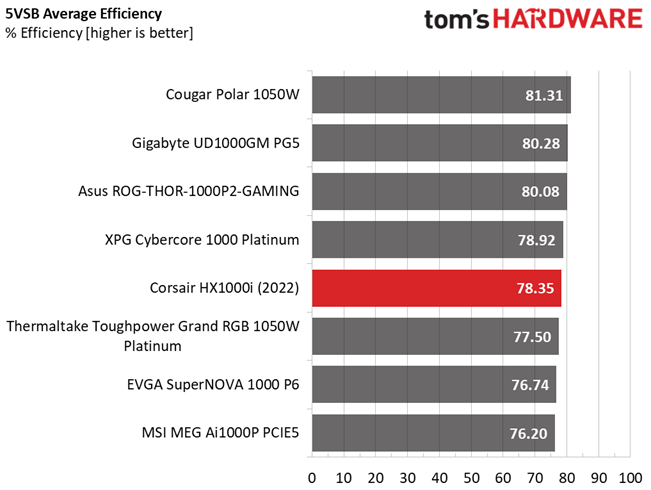
The cutting-edge platform that the HX1000i uses deserves a more efficient 5VSB rail.
Power Consumption In Idle And Standby
| Mode | 12V | 5V | 3.3V | 5VSB | Watts | PF/AC Volts |
| Idle | 12.078V | 5.059V | 3.304V | 5.059V | 3.912 | 0.239 |
| Row 2 - Cell 0 | Row 2 - Cell 1 | Row 2 - Cell 2 | Row 2 - Cell 3 | Row 2 - Cell 4 | Row 2 - Cell 5 | 114.95V |
| Standby | Row 3 - Cell 1 | Row 3 - Cell 2 | Row 3 - Cell 3 | Row 3 - Cell 4 | 0.021 | 0.002 |
| Row 4 - Cell 0 | Row 4 - Cell 1 | Row 4 - Cell 2 | Row 4 - Cell 3 | Row 4 - Cell 4 | Row 4 - Cell 5 | 114.95V |

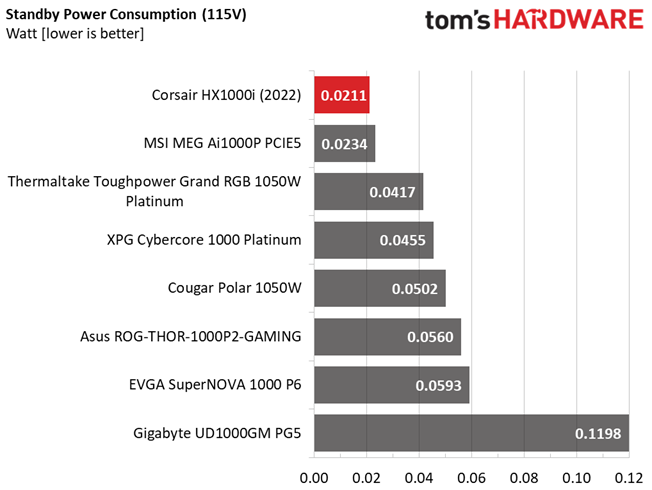
Vampire power is low.
Fan RPM, Delta Temperature, And Output Noise
All results are obtained between an ambient temperature of 37 to 47 degrees Celsius (98.6 to 116.6 degrees Fahrenheit).
The fan speed profile is tuned to not deliver high noise output, even under harsh conditions with high loads at increased operating temperatures.
The following results were obtained at 30 to 32 degrees Celsius (86 to 89.6 degrees Fahrenheit) ambient temperature.
At normal operating temperatures, close to 30 degrees Celsius, the PSU is silent with up to 700W loads, regardless of the minor rails' load. With more than 700W, it remains below 30 dBA until around 770W. With higher loads, noise output is within 30-35 dBA. The PSU's large dimensions allow for good airflow, and the big fan allow low noise output.
MORE: Best Power Supplies
MORE: How We Test Power Supplies
MORE: All Power Supply Content
Current page: Load Regulation, Hold-Up Time, Inrush & Leakage Current, Efficiency and Noise
Prev Page Specifications and Part Analysis Next Page Protection Features, DC Power Sequencing, Cross-Load Tests and Infrared Images
Aris Mpitziopoulos is a contributing editor at Tom's Hardware, covering PSUs.
-
Co BIY Another nicely done review. Seems lots of people will need a 1000 Watt supply now.Reply
This is the first time I've heard about PCIe 5.0 having anything to do with the power supply ?
Maybe in the next review you could explain this. -
jkflipflop98 I picked up a 1kw cooler master PSU about 10 years ago or so. It's still going strong.Reply -
escksu ReplyCo BIY said:Another nicely done review. Seems lots of people will need a 1000 Watt supply now.
This is the first time I've heard about PCIe 5.0 having anything to do with the power supply ?
Maybe in the next review you could explain this.
Its not really about the PCIE 5.0 slot but the power connector for graphics card. New graphics cards are supposed to utilise the so-called "PCIE 5.0 16pin power connector" (again, nothing to do with PCIE 5.0 slot).
Eg. the RTX4090 uses PCIE 5.0 16 pin power connector but its actually a PCIE 4.0 16x card.
You do not need any special PSU in order to utlise the PCIE 5.0 slot on your board. Currently there are no PCIE 5.0 devices other than SSD.
